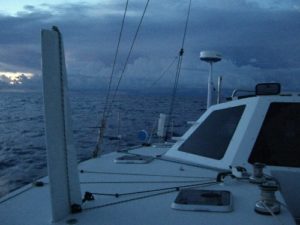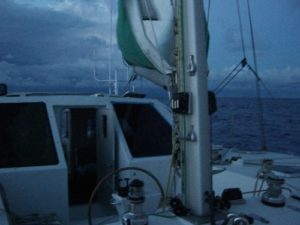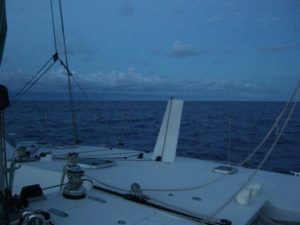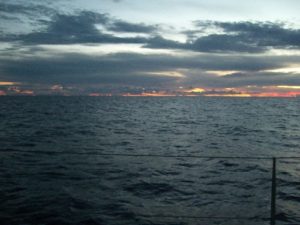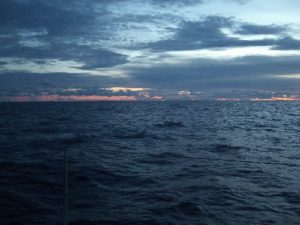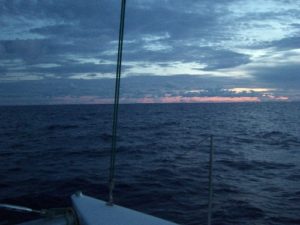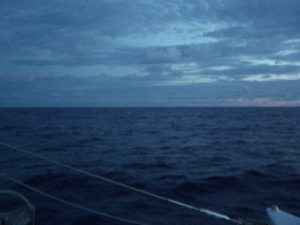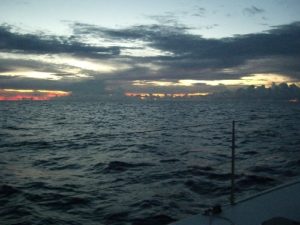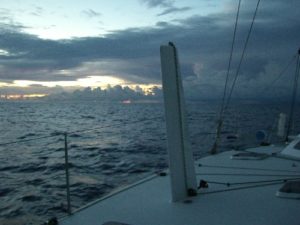Current Time: 2AM and 5:30 AM
Current Position: North 30 degrees 18 minutes, West 63 degrees, 06 minutes – about 100 miles south of Bermuda
Hi, Everyone.
Ch-ch-ch-changes. That’s one of the realities of sailing.
This afternoon we were still ghosting along, with the code zero sail up and a very calm sea, just tiny little waves, with one large swell coming from one direction and a smaller swell coming from another. In those situations, we go to the autopilot settings every few minutes, making minute variations in the setpoint for the autopilot, watching the apparent wind indicator (basically a small wind vane) at the top of the mast (which makes it tough to do when the sun is directly overhead), and standing on the afterdeck trying to feel where the real wind is coming from.
Just in case any sailor wanna be’s are curious, your face is a great wind direction indicator. When it’s blowing briskly, all you have to do is turn your face into the wind, and gently turn your head one way and the other. When the wind is blowing equally on both sides, that’s where the wind is coming from. When the wind is light, you can feel a coolness on your skin where the wind is coming from. You can also look at the water, which you can read like a book once you know what you’re looking at/for. On a calm day, you can see wind coming – darker areas on the surface of the water. When it’s gusty, you can see the gust coming, by the approaching dark patches on the water (called “cat’s paws”).
Back to now. As I write this, the boat is going 9 knots with the large jib, the code zero, still up. I may have to drop it tonight, if the wind gets stronger. The clouds overhead indicate some frontal activity – first there are the high, wispy clouds (sometimes including “mare’s tails”), then the mackerel clouds (which look like fish scales), then the rainy clouds, which could be puffy and filled with thunder and lightning or low and smooth. I could go get the weather book and impress you with my knowledge of different cloud types, and do a proper job of this, and I know at least three of them – stratus, cirrus, and cumulus – but right now I need to just keep typing, because I have so much to do on my watch tonight. Besides you all can Google them, something I can’t do out here.
The rain, if there is any in the area right now, looks to be aft of us, (to the south – we’re still heading north to Bermuda). As I track it on the compass, it appears to be moving from west to east. On the other hand, the moon is right above those clouds, so the darkness I’m seeing under the clouds- which is what rain looks like in a squall – could just be moon shadow. [Note – that is what it turned out to be, although I did get sprinkled later on.]
Andy M – the one in California (I know two Andy M’s, both wonderful dads with wonderful families)…anyway, Andy M’s kids wanted to know if we get tired of seeing all water all the time. I can only answer for myself, but I will ask Philip if he has anything to add in the morning.
But before I answer, here’s a series of shots I took one sunrise, to attempt to show what it actually is like, with “the sea all around you, all the time.”
Are we tired of seeing all water all the time?
My answer is no.
Before we set off on this journey April 20, I know I would have thought my answer might be yes. But now that I’ve been out here, day after day, I have a different perspective on it. First of all, the sea’s surface is constantly changing, and those changes are very important to your survival, so it’s not just like looking out over the water and contemplating your life. Sometimes you do that, but surprisingly seldom.
Consider that when I’m on watch, every ten minutes, from 1AM to 9AM, I am getting up from whatever I’m doing, and going out the forward and aft doors, and scanning the horizon for traffic. I’m also looking at the conditions. Is the wind coming from the same direction? Same speed? Where’s the swell coming from? What are the clouds doing? Is that a squall up ahead, with puffy clouds above and a dark area below? Where is it on the compass now? Are we sailing into it, or will it be past us by the time we get there? How are the sails doing? Are all the lines correct and properly stowed? Do I need to bring in the wash? 🙂 Are the daggerboards correct? Any strange noises? If it does rain, do I have buckets set up to catch rain water? If we are getting more wind, anything I need to do about it? There’s more – but you get the idea. Sailing on the ocean is serious busy-ness.
There is the issue of avoiding things in the water, but sailing out here is not like sailing in the lobster-trap-buoy-infested Narragansett Bay in Rhode Island. The first time we encountered those Styrofoam floats, which are connected to the lobster traps below, we were bringing Moonlight around Conanicut Island (that’s the real name of the island we live on; the town on the island is Jamestown). We had moved to Rhode Island (1996) and had Moonlight trucked across the country, and delivered to a boatyard on the east side of Conanicut Island.
That meant we had to sail the boat around the north end of Conanicut, and down the west side, to attach her to our mooring, off our beach. The wind was blowing pretty nicely on the northwest side of the island – I’d say about 25 – 30 knots. As we came around the island, we found ourselves in the midst of dozens of lobster trap buoys. New England sailors will laugh, but we had been sailing in San Francisco Bay for years – and there are no lobster trap buoys there. We had no idea if they were connected in any way, with horizontal lines from buoy to buoy, close to the surface of the water. Again, it seems really silly now, but for a minute or two, we wondered what to do – if we should try to find the edge of the lobster trap field and go around it.
We didn’t want to get a line stuck in our prop – which, it turns out, is easy to do, even though they are NOT connected with horizontal lines. You can be sailing along and all of the sudden you’re not sailing anymore, because you didn’t see a partially submerged buoy, and it has gotten stuck between the bottom of the boat and your prop shaft. Major problem. Major activity on deck, taking the power out of the sails, trying to figure out how to disengage the buoy line from your prop. The line is tight as steel rod (because it is now holding a 17,000-pound boat in place, against the current and wind), and may be so far below the water’s surface that you can’t see it – and a boat hook may not reach it. The water in Narragansett Bay is not warm, and a monohull doesn’t have those nice steps leading to the water, like a catamaran does. Plus, when it’s blowing, the water’s surface is rough. Obviously, you want to avoid this situation.
To finish the around-the-island story, we pretty quickly decided that the buoy field we were in could not possibly be as we feared, so we dove into it – and got the boat secured to her mooring a few hours later. That particular area of the bay is one of the most crowded, it turns out, as far as lobster traps go. And we no longer have any silly ideas about lobster trap buoys.
—-
It’s 5:30AM now.
I was watching the wind as I was writing. Before Philip had gone to sleep I told him I might want to douse the code zero sail if the wind got too brisk, and he was ok with that, so I was keeping an eye on the wind strength and our speed. Our speed started shooting into the stratosphere, and it didn’t look like it was going to ease any time soon, so I went for it about 3:30.
I just finished. Well, that’s not technically true. I finished everything by the tidying up by 5AM, and then had to tidy up all the lines and watch some traffic crossing our bow way off on the horizon. I learned something when I was doing that. When a ship is far enough away, a white light can have a bit of a red tinge to it when you look at it through the binoculars. Fortunately I also got a bearing on the ship right away, looking at it from behind the compass on the steering pedestal. The ship’s bearing, relative to us, was 320 degrees.
First I got the bearing, then I got the binoculars…and looking at the lights (very shaky, even if you put the binoculars on a winch to steady them, a trick Philip taught me today), I thought I saw a red light along with the usual two white lights. So I thought, OK, if that’s true, the boat is heading away from us (it was to the left of us, and if his red light is showing, that’s his left side – port). But I also kept checking the bearing, and saw that he was moving to the right, not left, which meant he was crossing our bow. When I first looked, he was at 320, then 330, then 335. So he was definitely moving to the right. I checked again with the binoculars until I couldn’t see him anymore (he was going away from us), and never did see the green light.
Dousing the big sail tonight was a definite challenge. The wind was brisk. Right now we have a full main up (which should probably be reefed, but that’s a two-man job) and a very tiny jib up. And we’re still going 7 – 8 knots. The wind is probably in the high teens. To get the code zero down, I had to turn the boat downwind (away from the wind), so the mainsail “blanketed” the code zero sail enough to make it start collapsing. There was no way that hoop and sleeve was going to come down from the top of the mast over that full sail, without taking some power out of the sail. I know, because I tried.
What you’re doing when you’re pulling the sleeve down over the sail is lying on your back on the trampoline, with your feet facing aft, pulling the “snuffer line” – which is attached to the hoop at the bottom of the sleeve – all the way down, over the sail. As you do that, you also have to be able to ease the line at the aft bottom end of the sail (the “clew”), under control, so the sail can collapse entirely, and go into the sock as it comes down, at just the right rate. That clew line – it’s actually the code zero “sheet” – goes from the clew to a block (pulley) at the edge of the deck, back by the pilothouse, and then leads forward again and is snugged off at the jib winch. So I released that line from that winch before I started pulling the sleeve down, and only had one wrap of line around the winch, just to give a little friction, but still let the line run free. If there are two people on watch, one of them can be easing this line as the other person is pulling the sleeve down. But there was no reason to wake him up.
Once you get the 50-foot (roughly) snake down on deck, you need to first secure it enough to start working on it, and then carefully flake (fold) the whole snake down neatly onto the trampoline. Then all of that has to be tied down very securely to the trampoline, with long pieces of webbing. I tied it well enough that even if we hit a squall, and there are wind and waves trying to pick up the flaked snake, it will stay put.
The work I need to do is still waiting for me, so I must sign off for now.

